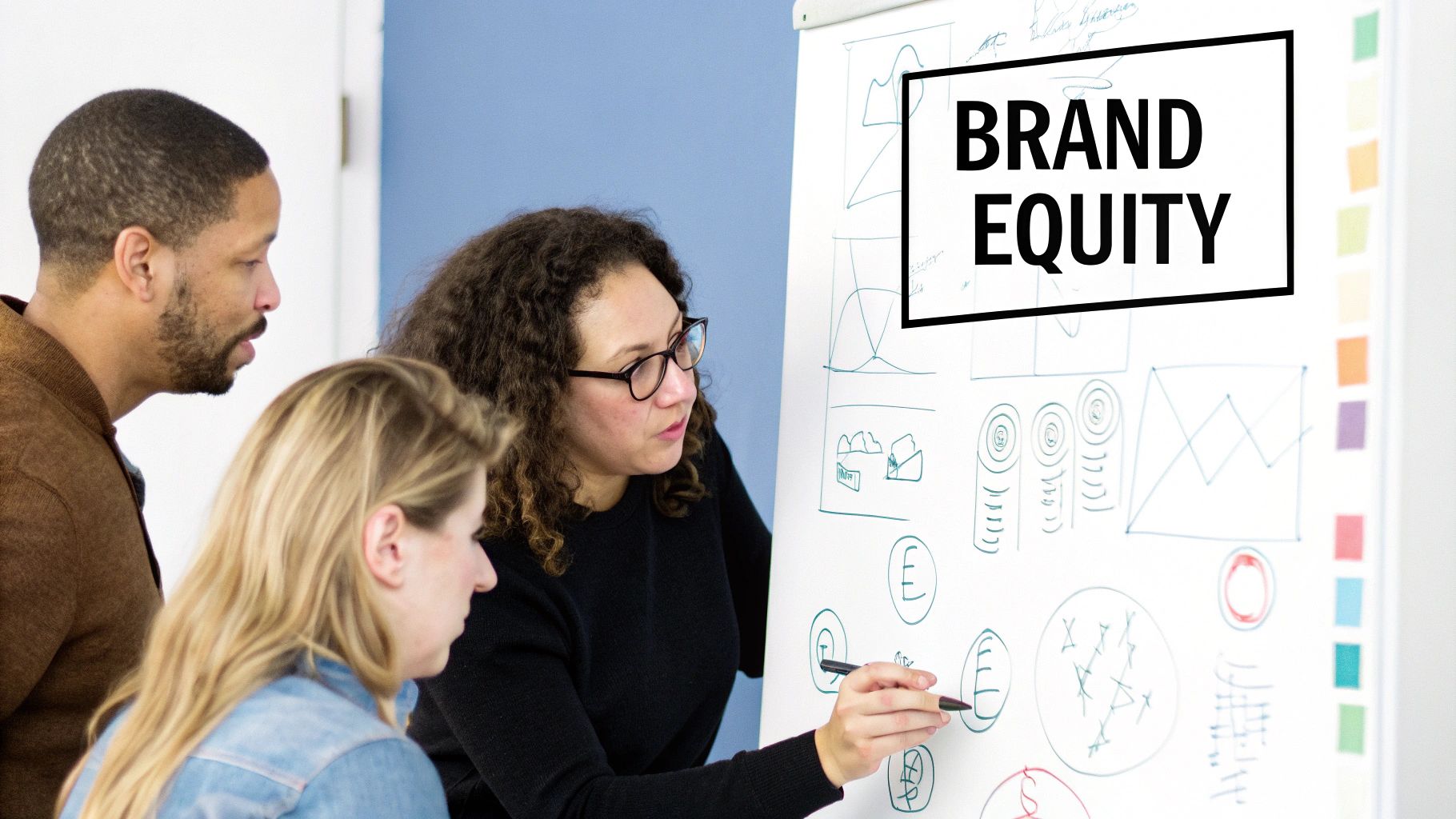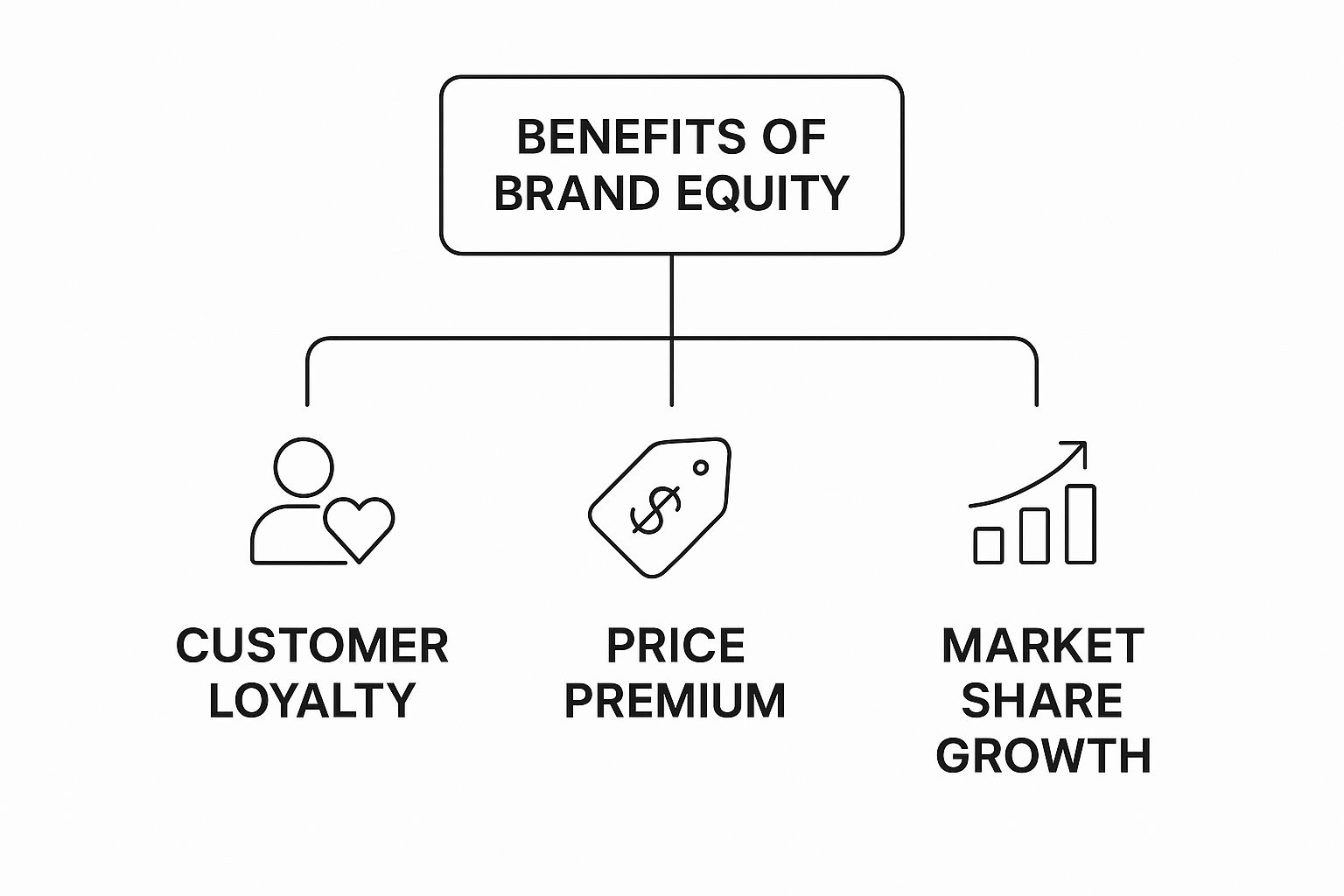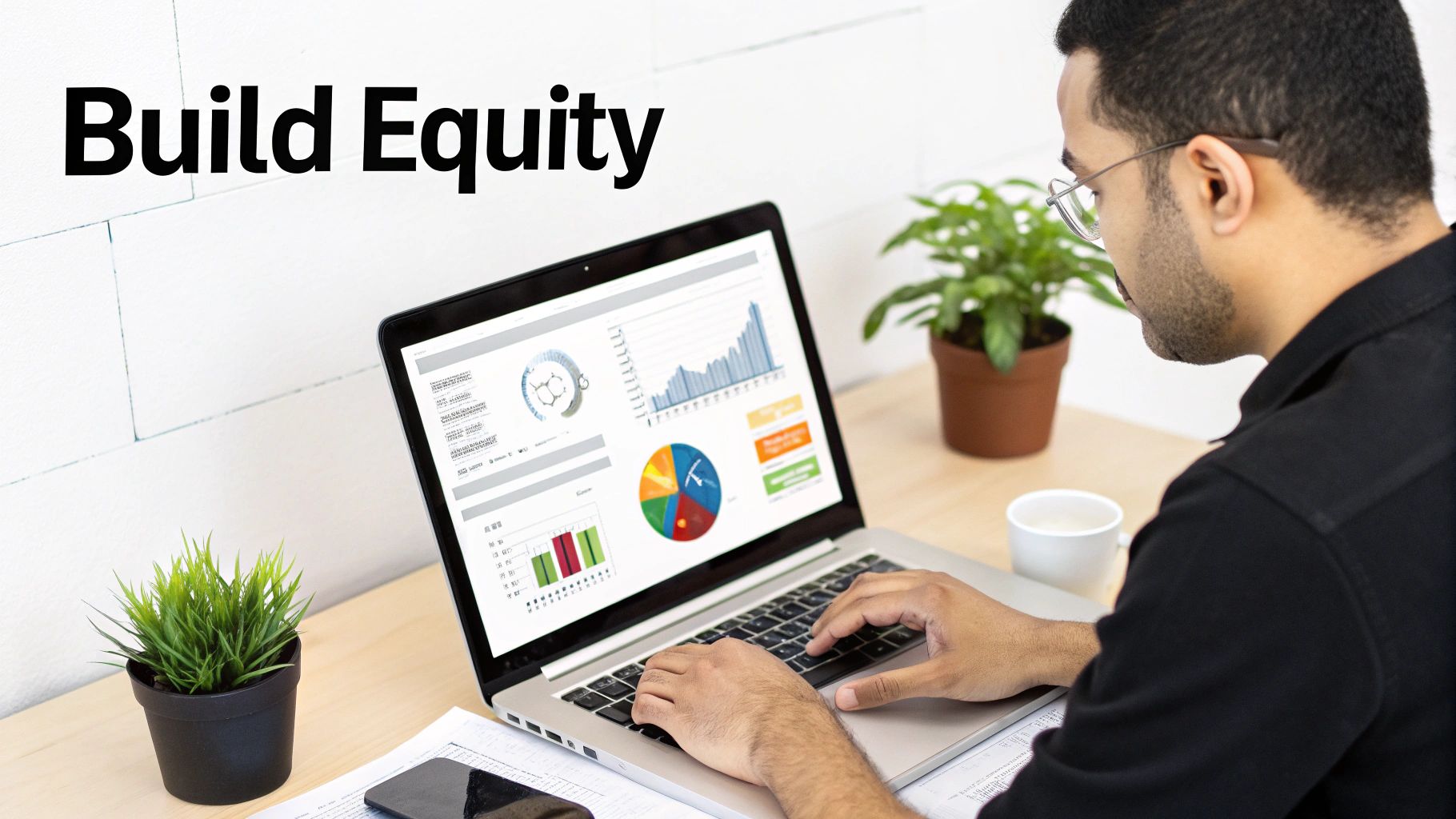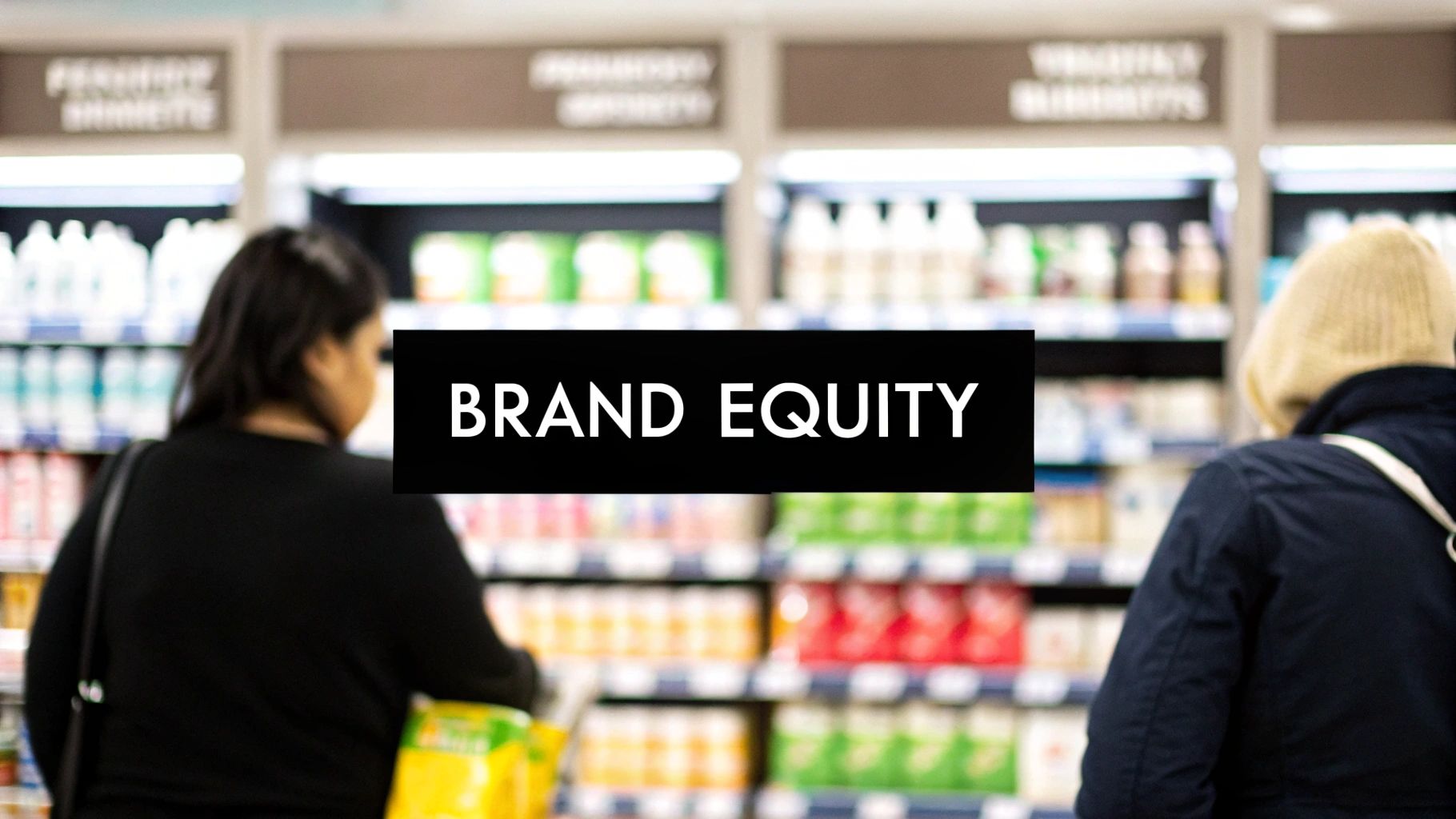Let's cut through the jargon. Brand equity is simply the value your brand name holds in a customer's mind. Imagine you're at the store and you reach for a familiar brand over a generic one, even if it costs a little more. That split-second decision based on trust and preference? That's brand equity in action.
Why Brand Equity Is Your Most Valuable Asset

So, what is brand equity beyond a textbook definition? Think of it as your company’s reputation and influence, but turned into a real asset. It’s the sum of every experience, perception, and feeling someone has with your name, logo, and messaging.
It’s the reason the Starbucks mermaid or the Nike swoosh makes you feel something before you even see a product. A new company can have a brand identity—a logo and a name—but it doesn't have equity just yet. Equity is something you earn over time, one positive interaction at a time. This value is what turns a simple product into a beloved brand.
To give you a clearer picture, here's a quick rundown of the core concepts we're talking about.
Core Concepts of Brand Equity at a Glance
This table shows how these individual pieces come together to create that powerful, intangible value we call brand equity.
The Real-World Impact of Strong Equity
Strong brand equity isn't just a fluffy marketing goal; it delivers real, tangible results that hit your bottom line. It acts like a protective shield, making your business more profitable and resilient. When customers truly trust your brand, their behavior shifts in your favor.
This shift shows up in a few powerful ways:
- Price Premium: People will happily pay more for your products. They trust the quality and the experience you deliver. In fact, one study found that 77% of consumers are willing to pay more for a brand they trust.
- Customer Loyalty: Shoppers will pick you again and again, even when cheaper or more convenient options pop up. This creates a predictable and stable source of revenue.
- Market Expansion: It becomes so much easier and less risky to launch new products. Your existing customers are already primed to try a new offering from a brand they know and love.
- Competitive Advantage: Your equity creates a powerful barrier that competitors can't easily cross. It's incredibly hard for a new player to replicate years of built-up trust and positive feelings.
In essence, brand equity is the difference between a one-time transaction and a lasting relationship. It’s the reason a customer feels good about their purchase and keeps coming back for more.
Building Equity From The Start
For any new business, getting this right from day one is crucial. Every single decision—from your logo to your customer service replies—either builds up or tears down your brand equity. It’s a long-term investment that pays off enormously through customer retention and market authority.
For startups eager to build a strong foundation, a solid branding strategy is the first step. You can explore this comprehensive guide to branding for startup companies to see how to kickstart this process effectively.
Ultimately, your brand's name can become one of its most valuable assets—often worth far more than your physical offices or equipment. It lives in the hearts and minds of your audience, steering their decisions and securing your place in the market.
The Four Pillars of Powerful Brand Equity
So, what does it take to build real brand equity? It isn't just about one viral campaign or a clever logo. The world's strongest brands didn't just stumble into success; they built their reputation on four key pillars.
Think of these as the legs of a table. If one is weak, the whole thing gets wobbly. But when all four are solid, your brand becomes a sturdy, reliable presence in the minds of your customers. Let's break down each one.
Pillar 1: Brand Awareness
First things first: people need to know you exist. This is Brand Awareness, and it's the absolute starting point. Can a customer recall your name or pick your logo out of a lineup when they have a problem you can solve? If not, nothing else matters.
Awareness isn't just about being seen, though. It's about being remembered at the exact moment a customer is ready to buy. It's the difference between being a complete unknown and being a real contender in their mind. To get started, you'll want to understand how to effectively build brand awareness, as this is the essential first step.
Pillar 2: Brand Associations
Once people know who you are, what do they think of you? That's where Brand Associations come in. This pillar covers every single thought, feeling, and memory a customer connects with your brand. It’s the story they tell themselves about you.
See a swoosh, think "performance" and "Just Do It." See the golden arches, think "burgers" and "I'm lovin' it." These connections are built over time through your ads, your customer service, your packaging—everything. The goal is to shape these associations to be positive and distinct, whether you want to be known for "luxury," "innovation," or "down-to-earth reliability."
A brand's associations are the story customers tell themselves about you. The stronger and more positive that story is, the deeper their connection will be.
Pillar 3: Perceived Quality
The third pillar, Perceived Quality, is all about how good customers believe your product or service is. This isn't necessarily about technical specs on a sheet; it’s about the customer's gut feeling of your brand’s superiority. Does it feel durable? Does the service feel trustworthy?
This perception is shaped by a mix of signals:
- The Obvious Stuff: Quality materials, slick design, and thoughtful packaging.
- The Vibe: Great customer service experiences, glowing online reviews, and a solid reputation.
- The Price Tag: Sometimes, a higher price can signal to customers that something is higher quality.
A brand with high perceived quality can charge more and earns a ton of trust. Apple is the master of this. People line up convinced of the superior quality of a new iPhone before they’ve even held it, all because Apple has spent decades building that perception.
The image below shows how all this effort pays off.

As you can see, building up these pillars directly leads to more loyal customers and better pricing power—the fuel for real business growth.
Pillar 4: Brand Loyalty
Finally, we arrive at the ultimate goal: Brand Loyalty. This is what you get when the first three pillars work together perfectly. It’s when a customer chooses you again and again, almost automatically, turning down all other options. They stop being just customers and become true fans.
This is the holy grail. Loyalty gives you a predictable stream of revenue and slashes your marketing costs. Loyal customers don't flinch at small price increases, and they’re more likely to forgive you for a minor mistake. Better yet, they'll be the first to try your new products and will eagerly recommend you to their friends, creating a powerful cycle of growth.
This loyalty is worth a fortune. A recent analysis found the combined value of the Top 100 global brands hit a staggering $10.7 trillion. Tech titans like Apple, with a brand value soaring to $1.3 trillion, lead the pack precisely because their brand equity creates unbreakable customer loyalty and market power. It’s definitive proof that a strong brand is one of the most valuable assets a business can own.
How to Measure Your Brand Equity Effectively

Knowing what brand equity is is one thing. Actually measuring it is where the rubber meets the road. After all, if you can’t put a number on your brand’s strength, how can you know if your strategies are working?
There’s no magic calculator for brand equity. You can’t just plug in a few variables and get a single, clean answer. Instead, the best approach is to look at it from two different but equally important angles: its financial value to your business and its psychological grip on your customers. By blending these two perspectives, you get a much clearer, more complete picture of your brand's health.
The Financial Approach: What's Your Brand Worth in Dollars?
One of the most concrete ways to gauge brand equity is to look at the hard numbers. Financial metrics cut through the noise and show you the tangible, bottom-line impact of having a strong brand. They answer a simple question: "How much more valuable is our business because of our brand name?"
This approach is all about analyzing business data to find where your brand gives you a competitive edge. Here are a few key metrics to watch:
- Price Premium: This is the ultimate test. How much more are customers willing to pay for your product over a generic or unbranded version? If you can charge more without losing customers, that extra margin is a direct result of your brand equity.
- Sales Volume: Take a look at your sales figures and compare them to your direct competitors. When you consistently outsell others in your category, it’s a strong sign that customers prefer your brand for reasons beyond just features and price.
- Market Share: What percentage of the market do you own? Your slice of the pie is a powerful indicator. A growing or dominant market share proves that, when given a choice, a significant number of customers are choosing you.
Think of it this way: when your brand name alone lets you sell more products at a higher price, you have undeniable proof of its value. These financial indicators aren't just vanity metrics; they are the direct result of the trust and preference you’ve worked so hard to build.
This data tells you what is happening. But to understand why, you need to get inside your customers' heads.
The Consumer-Focused Approach: Listening to Your Audience
The other side of the coin is all about customer perception. This method is less about spreadsheets and more about psychology. It helps you uncover the thoughts, feelings, and beliefs that are driving the financial results you’re seeing.
Gathering this feedback is crucial for understanding the health of your customer relationships. The goal here is to turn feelings into data.
You can do this in a few different ways:
Brand Awareness Surveys: First, you need to know if people even know who you are. You can measure this with unaided recall (e.g., "When you think of electric cars, what brands come to mind?") and aided recall (e.g., "Which of these car brands have you heard of?"). High awareness is the foundation of brand equity. For more on this, check out our guide on how to improve brand awareness.
Customer Loyalty Metrics: Tools like the Net Promoter Score (NPS) are fantastic for this. Asking a simple question—"How likely are you to recommend us to a friend?"—reveals a ton about satisfaction and loyalty. Promoters are your brand champions.
Perceived Quality and Association Surveys: These surveys dig deeper. They ask customers to rate your brand on specific traits like quality, innovation, trustworthiness, or value. This is how you find out if the brand identity you're trying to project is actually what people perceive.
By combining the financial and consumer-focused methods, you get a full 360-degree view. The numbers tell you how you’re doing, and the customer feedback tells you why. This complete picture is what you need to make smart decisions and continue growing your brand's most valuable asset.
Actionable Strategies for Building Brand Equity
So, you understand what brand equity is and how to track it. Now for the fun part: actually building it. This isn't about launching a single, flashy campaign and calling it a day. Real brand equity is built brick by brick, through consistent, thoughtful actions that make your brand a trusted friend to your customers.
The goal is to shift from being an option to being the option. And these strategies aren't just for the big players with bottomless budgets. They're practical, sustainable tactics any business can start using today. It all starts with knowing who you are and showing up as that same brand, every single time.
Create a Consistent and Memorable Brand Identity
Consistency is the bedrock of strong brand equity. Your brand needs to look, feel, and sound the same no matter where a customer bumps into it. That predictability builds trust and makes you instantly recognizable. When people know what to expect, they feel more comfortable choosing you.
A huge piece of this puzzle is crafting a remarkable brand identity, where your brand's voice is just as important as its logo. Think about:
- Your Visuals: Your logo, color scheme, and fonts need to be consistent across your website, social media profiles, product packaging, and ads.
- Your Messaging: The personality you project—whether it's professional, quirky, or inspirational—should come through in every tweet, email, and product description.
- Your Promise: If your brand promises simplicity, then every interaction, from checkout to customer support, has to deliver on that promise.
For smaller businesses, this relentless focus on consistency is a secret weapon. You can get more specific ideas from these top branding tips for small business success, which show how to create a cohesive experience right from the start.
Deliver an Exceptional Customer Experience
Having a great product is only half the story. Brand equity is really built along the entire customer journey, from the first ad they see to the help they get months after their purchase. A stellar customer experience is one of the most powerful ways to create positive feelings and fierce loyalty.
Think about the brands you personally love. Chances are, it’s not just the product you admire, but the feeling of being seen and valued. Every touchpoint is a chance to polish your reputation. This means making it easy to buy, offering support that’s actually helpful, and personalizing communication whenever you can.
An exceptional customer experience turns a simple transaction into a memorable relationship. It's the human element that builds lasting trust and separates beloved brands from forgettable ones.
Foster a Powerful Brand Community
The strongest brands don't just push products; they pull people together and create a sense of belonging. When you build a community, you turn customers into genuine fans and advocates. You create a space where people feel connected to your brand and, just as importantly, to each other.
Here’s how you can start nurturing that community:
- Engage on Social Media: Don't just broadcast your message. Ask questions, run polls, and share content from your followers to make them feel like part of the conversation.
- Create Exclusive Content: Give your followers a reason to stick around with valuable content like webinars, tutorials, or behind-the-scenes glimpses that aren't available anywhere else.
- Encourage Connection: Set up a dedicated space—like a private Facebook group, a Slack channel, or a forum—where your biggest fans can connect and share their passion.
The payoff for this kind of work is huge. Even with a sluggish global economy, the total value of the world's top 500 brands recently climbed to almost USD 9.5 trillion. This shows just how much a strong brand, built on great experiences and community, can protect a business from market swings. By focusing on these steps, you can start building an asset that only gets more valuable over time.
Case Studies of Exceptional Brand Equity

Theory is one thing, but seeing brand equity in action is what makes the concept truly click. The world’s most iconic brands aren’t just selling products; they’re selling feelings, identity, and trust. They have masterfully built their equity over decades, turning their names into immensely valuable assets.
Let’s pull back the curtain on a few legendary examples to see exactly how they did it. These stories offer a real-world look at what’s possible when you consistently nurture your brand.
Coca-Cola: The Master of Timeless Consistency
When you think of Coca-Cola, what comes to mind? For most of us, it’s a flash of classic red, a feeling of happiness, and the idea of sharing a moment. Coca-Cola pulled this off through an unwavering commitment to consistency for over a century.
From its timeless script logo to its core message of "happiness," the brand has rarely strayed. This relentless repetition has burned its identity into our collective culture.
Their equity is built on a few key pillars:
- Deep Awareness: It’s one of the most recognized brands on the planet. You can find a Coke almost anywhere.
- Positive Associations: Decades of advertising have linked the drink to joy, togetherness, and the holidays.
- Immense Loyalty: For many, no other cola will do. It’s the default choice, a habit often passed down through generations.
This is what brand equity looks like when it becomes a cultural fixture. Coca-Cola doesn’t just sell a beverage; it sells a feeling of familiarity and comfort.
Disney: The Architect of Emotional Connection
Disney’s brand equity is built on the most powerful human element there is: emotion. The company isn’t just an entertainment studio; it’s a master storyteller that has forged deep, personal connections with families for generations.
The Disney name is basically shorthand for magic, wonder, and family-friendly entertainment. This powerful association gives them an incredible advantage. A movie with the Disney castle in the opening credits instantly carries a promise of quality and a certain kind of feeling.
Disney’s magic lies in its ability to build a world that people want to be a part of. The brand equity is so strong that customers trust it implicitly, whether for a film, a theme park, or a toy.
This trust allows Disney to extend its brand into countless ventures with an almost guaranteed head start. Their equity is so powerful it creates a halo effect—the positive feelings for one part of the brand (like a beloved movie) transfer to all the others.
Nike: The Champion of Aspirational Identity
Nike built its empire not just by selling shoes, but by selling an idea: the idea that everyone is an athlete. The brand’s iconic "Just Do It" slogan is more than a tagline; it’s a personal call to action that connects with people on a deep level.
Nike’s equity is rooted in powerful brand associations. By aligning itself with top-tier athletes and inspirational stories of overcoming the odds, Nike has made its brand synonymous with determination, peak performance, and victory.
When people buy a Nike product, they aren't just buying gear. They're buying into that aspirational identity. They're connecting with a community of people pushing their limits, which has created a fierce sense of loyalty and turned the swoosh into a badge of honor.
Nation Branding: The Ultimate Scale of Equity
The idea of brand equity scales up, way beyond corporations. It also applies to entire countries in a practice known as nation branding. Just like a company, a nation’s reputation influences everything from tourism and foreign investment to its global standing.
And this isn't just a fluffy concept—it's backed by serious numbers. The United States, for instance, holds the title of the world's most valuable nation brand, with a valuation of $37.3 trillion. That’s a 16% increase tied directly to its economic performance.
Even nations facing economic headwinds, like China, maintain high brand value through cultural influence and the reach of their global companies. These rankings show how a country's economic health and geopolitical standing directly shape its brand equity on the world stage. You can explore more about these global brand dynamics to see how this plays out internationally.
How to Protect Your Brand Equity from Threats
You can spend years building up incredible brand equity, but it can all come crashing down in a surprisingly short amount of time. Think of all that trust, loyalty, and positive feeling you've worked so hard to build. It's one of your most valuable assets, but it's also incredibly fragile. Protecting it is just as important as building it.
Most of the time, the threats aren't big, dramatic scandals. It's more like a slow leak. Inconsistent messaging, a bad customer service interaction that goes viral, a product that doesn't live up to the hype—these are the little things that can slowly erode the foundation of your brand.
Proactive Defense is Your Best Offense
The smartest way to guard your brand's value is to get ahead of potential problems. Don't wait for a crisis to figure out what to do. You need a solid game plan in place before things go wrong. This means setting crystal-clear standards for how your brand acts and looks, no exceptions.
Here are a few core strategies that act as a powerful defense:
- Create Ironclad Brand Guidelines: This is your brand's bible. It needs to cover everything from logo placement and color codes to the specific tone of voice you use in emails and social media. When everyone—from marketing to sales to your external partners—is on the same page, your brand stays consistent and strong.
- Monitor Your Brand's Reputation: You have to listen to the conversation happening about you online. Use social listening tools, keep an eye on review sites, and see what people are saying. Catching negative comments or a brewing issue early gives you a chance to fix it before it becomes a full-blown crisis.
- Have a Crisis Management Plan: The worst time to make a plan is in the middle of a storm. Know ahead of time who is in charge, what the chain of command is, and what your first steps will be. A pre-approved plan lets you respond with speed and confidence when the pressure is on.
Learning from the Storms
We can learn the most from watching how other brands handle tough situations. The ones who come out stronger are almost always the ones who own their mistakes, communicate with radical transparency, and take real action to solve the problem. Sometimes, a quick, honest response can actually build more trust than you had before.
A brand's reputation is like a reservoir of goodwill. Every positive interaction adds to it, while every negative one drains it. A crisis can drain it quickly, but a deep reservoir built over time gives you the capacity to weather the storm.
On the flip side, brands that try to hide, deny, or point fingers often face damage that's impossible to repair. People can spot inauthenticity from a mile away, and once that trust is gone, it's incredibly hard to get back. Protecting what you've built means being vigilant and living up to your brand's promise, day in and day out.
Frequently Asked Questions About Brand Equity
We've covered a lot of ground, but you might still have a few questions rattling around. Let's tackle some of the most common ones to make sure everything is crystal clear.
Brand Equity vs. Brand Value: What’s the Real Difference?
It’s easy to mix these two up, but they represent two different sides of the same coin. Think of brand equity as the cause and brand value as the effect.
Brand equity is all the goodwill, trust, and positive feelings you’ve built up in your customers' hearts and minds. It’s the reason they feel a connection to you. Brand value, on the other hand, is the cold, hard financial figure that an accountant can put on your brand. You build up all that positive equity to create tangible, measurable value for your company.
Can a Small Business Really Build Strong Brand Equity?
Not only can they, but small businesses often have a secret weapon: personal connection. You don't need a nine-figure marketing budget to build powerful brand equity.
As a small business, your strength lies in authenticity and consistency. You can build incredible equity by:
- Dominating a specific niche and becoming the undeniable expert everyone turns to.
- Providing genuinely memorable customer service that people can't help but rave about.
- Fostering a real community around a shared passion or set of values.
So, How Long Does This Actually Take?
Building brand equity is a marathon, not a sprint. A single viral campaign might get you a quick spike in awareness, but creating the deep-seated loyalty that defines true brand equity is a long game. It demands patience.
Brand equity is built brick by brick, through countless positive interactions and consistently delivering on your promises over months, and even years. Every customer touchpoint is another chance to strengthen that foundation.
There are no shortcuts here. Earning genuine trust takes a long-term commitment to being excellent in everything you do.
Is Brand Equity Just a Fancy Term for Brand Awareness?
Nope, and this is a critical distinction to grasp. Brand awareness means people know you exist. They recognize your logo or name. It's the first, most basic step.
Brand equity is what happens next. It's the difference between being known and being loved. Equity means customers don’t just know who you are—they actively like, trust, and choose you over everyone else, even if you cost a little more. Awareness gets your foot in the door, but brand equity is what convinces people to invite you in and stay.
Ready to build a brand that commands attention and inspires loyalty? Softriver specializes in creating custom brand identities that lay the perfect foundation for strong equity. Our team of expert designers will work with you to craft a timeless logo and a complete brand system that makes an immediate impact. Get your professional brand identity started today at Softriver.co.







